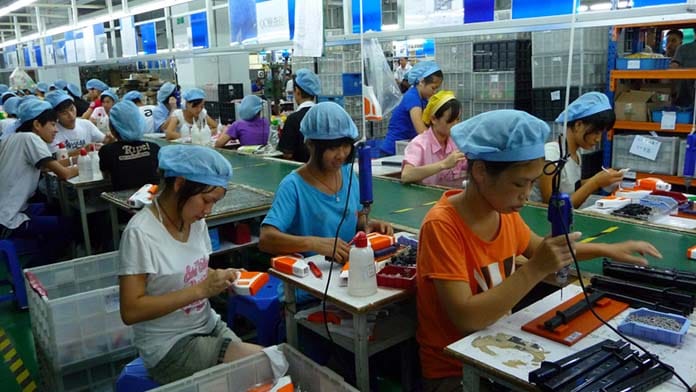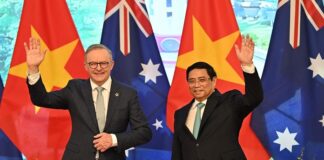Griffin Phillips reviews a new book that charts China’s emergence as an economic power, the growth of an immense working class and the likely turmoil ahead
It has always been important for socialists to understand China but there is added urgency today as the Australian government openly prepares for war against China if US-led efforts to contain it fail.
Our rulers want us to believe that this is a contest between democratic states and a “totalitarian regime” that seeks to dominate the region. The past year in Gaza has shown us in graphic detail what all that talk about “freedom”, “human rights” and “the rules-based international order” actually amounts to.
Most ordinary people do not want war with China, but neither do they want Xi Jinping-style authoritarianism to spread. The fundamental problem here is that too few see any realistic hope of an alternative emerging from within China itself.
That’s why Adrian Budd’s new book, China: Rise, Repression and Resistance, is so important. It shows that China’s economic and political system are much more like those in the US and Australia than either regime wants to admit.
The most important consequence of China’s rise has been the creation of the largest industrial working class in the world—workers who have protested, organised, gone on strike and rioted in defence of their wages, living conditions and rights as human beings.
It is in their hands that the future of China lies.
Economic development
Budd first sets out to establish that the People’s Republic of China is, and always has been, capitalist—not socialist nor communist in any way.
Why does this matter? Because, on both sides of this vicious competition the economy is controlled by billionaires and gigantic corporations.
China has 124 corporations in the Fortune magazine Global 500; the USA 121. At last count, China had 814 billionaires; the USA 800. In 2010 in China, the richest 1 per cent owned 41 per cent of total wealth; in the USA it was 40 per cent—and inequality in both is getting worse.
Budd enables us to see the ways that Chinese capitalism is both similar to, and different from, Western capitalism.
He argues—as Solidarity always has—that the Maoist regime that triumphed in the revolution of 1949 was a form of capitalism, state capitalism, in which the labour of workers and peasants was directly exploited by the state in the hope of catching up with the rich countries of the West. The result was economic development punctuated by extreme crises.
After the chaos of the Cultural Revolution the Chinese leadership turned towards “reform and opening up”.
This was the Chinese version of neoliberalism, starting with the dismantling of rural communes, allowing township enterprises and deregulating and decentralising much of the economy. They also experimented with free trade zones in a few coastal areas that gave foreign capitalists access to low waged labour, virtually untaxed.
The success of all these led to the privatisation and restructuring of most state-owned enterprises (SOEs), costing 45 million workers their jobs. While SOEs are still central to the economy, private capital is now responsible for 60 per cent of GDP and 90 per cent of exports.
The prize for all these “reforms” was membership of the World Trade Organisation, which gave China’s exporters access to global markets for goods they could produce cheaper than anyone else. Foreign capital flooded in, turbo-charging growth. In 1978, China accounted for just 1 per cent of global GDP; today it’s 18 per cent. It produces 32 per cent of all manufactured goods in the world, double the US and five times Japan.
This success was built on the back of extreme levels of exploitation. From 1983-2005, the share of national output going to wages fell from 57 per cent to 37 per cent. This allowed the ruling class to accumulate capital at an extraordinary rate—double the average in Western economies—allowing vast investments in new means of production.
A new working class
That economic dynamism required labour. Hundreds of millions of people from poor farming villages were drawn to work in the cities. The urban population quadrupled.
People moved because wages and living conditions in the cities were better than in the villages but the work regimes they faced were relentless. In the early 2000s, three quarters of migrants worked seven days a week and 100,000 workers a year were killed at work.
So from the 1990s on, this massive new working class began to fight back. Official figures show mass protests rising from 10,000 in 1993 to 60,000 a decade later. Police violence failed to contain the unrest and by 2007 there were 360,000 strikes and double that the following year, especially in the automobile, textile and electronics industries.
Many strikers won their demands quickly and this forced local authorities to double minimum wage rates. But as Budd argues, “The greatest impact was on the workers themselves, who demonstrated not only determination but also a growing, though still limited capacity to act independently of the official trade unions” which are directly controlled by the ruling Communist Party.
It was also clear that “embryonic plant-level rank-and-file organisation was developing”. This was assisted by the rapid growth of pro-worker NGOs which gave workers advice about their legal rights.
One highpoint was the massive 2014 strike at the sprawling YueYuen footwear factory complex in Dongguan, southern China, which produced for global brands such as Nike and Adidas. Forty thousand workers, largely women, came out over the failure of the business to pay their social security contributions. After confrontations with police and many arrests, the company paid up and raised wages as well.
These victories threw up a layer of self-conscious worker-militants who saw Chinese society as fundamentally divided by class. They assisted workers in other factories and advised them on how to wage a successful strike. The possibility of a future, mass revolutionary leadership grounded in the Chinese working class was clear.
For ordinary workers, the experience of China’s boom has been extremely mixed. On the one hand, their militancy has forced a historic rise in incomes. Average annual wages in China rose from less than 4 per cent of those in the US in 2001 to around 30 per cent by 2021; nearly eight times as much in less than a generation. The fact that everyday goods are so much cheaper than in the West means that the gap in living standards is much narrower.
The purchasing power of 2000 yuan per month, about the average legal minimum wage, is only some 20 per cent less than that of the federal minimum wage in the US.
This is important in understanding one aspect of both the strength and vulnerability of the CCP. Many Chinese give great credit to the regime for China’s rise and improved living standards. But young people have no memory of life in 2010, much less 1949. They expect further improvement but falling growth rates and the current crisis of overproduction mean the system is less and less able to deliver.
They still face appalling working conditions—996 work culture (9am to 9pm, six days a week); lack of job security, non-payment or underpayment of wages and promised bonuses; wages linked to revenue (in hospitals, for example); the use of ultra-low-waged fake intern positions for factory work, lack of health care and compensation when injured.
All this is driving high levels of alienation and discontent among young people.
The strike wave of the mid-2010s ended in repression but strikes and protests have continued. In 2022, a walkout by some 200,000 workers at the Foxconn plant in Zhengzhou against COVID restrictions, along with small but brave “White Paper” protests across China, created panic in the regime. It suddenly reversed course and opened up.
All this shows that the regime is far from the all-powerful, totalitarian monolith portrayed in the West.
Chinese capitalism
One important element of weakness in the regime stems from decisions from the 1980s to decentralise government power.
Provincial and local officials were given virtually free rein to compete for investment, labour and infrastructure, and to decide for themselves how to subsidise and regulate business in their regions. One academic calls the system “one country, thirty-two economies”—the number of provincial and quasi-provincial governments.
Budd describes the way, “Many collective enterprises are owned and run by capitalists, while many private enterprises are spun off of state properties owned and run by cadres or their kin”, amid “a constant migration of party and state officials into the private sector”.
The central state still plays a major role but it is much the same kind of role we see in Western economies; top level regulation, subsidising strategic industries, fiscal and monetary policy. It also controls many major enterprises and the largest banks, just as many Western states did before neoliberalism, but as in the West, capitalism is driven by its own logic—“the private interests of capitalists and local bureaucrats frequently combine to thwart the central state”.
The authoritarianism of the Xi regime is an attempt to partially re-centralise power and deal with a range of these economic and social stresses. They’re thrashing around trying to revive a sluggish economy as liberal critics demand more rights for private capitalists, capitalists demand large-scale stimulus and nationalists demand no retreat from state ownership.
With childbirth numbers collapsing, local officials are ringing women to ask if they’re planning to get pregnant. Their efforts are being openly ridiculed online.
The regime’s answer to its problems is to demand sacrifice. It resisted any substantial improvement in welfare, meaning that hundreds of millions of older people still live in terrible poverty.
At some point the Chinese working class will need to move from conflict with individual employers to confrontation with the regime as a whole. The outcome of that struggle will have a huge impact on the future of us all.
Here in Australia we can play a role—by rejecting anti-Chinese protectionism, fighting everywhere against AUKUS and the drive to war, by taking any opportunity to offer solidarity with workers’ struggles in China. We need to build a movement that shows Chinese workers that we know that Albanese and Dutton, Harris and Trump are our enemies as well as theirs; that their struggles are our struggles too.
China: Rise, Repression, Resistance, By Adrian Budd, Bookmarks 2024, $25






